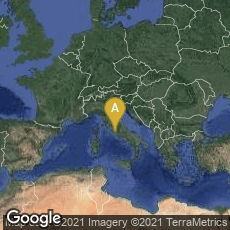

Water pipe with Latin inscription from the reign of Vespasian. The text is unusual for being sunk into the surface and for its length of 1 meter. The most plausible explanation for these inscriptions is that they were made from "common text stamps."
Lead water pipes from the Roman Empire sometimes contain inscriptions on their surfaces. For example, a section of pipe from the reign of the Emperor Vespasian (69-79 CE) preserved in the Grosvenor Museum in Chester, England, and illustrated in the Wikipedia article on Roman lead pipe inscriptions, contains an inscription one meter long. The technology of creating these inscriptions was only recently understood.
"A recent investigation by the typesetter and linguist Herbert Brekle, however, concludes that all material evidence points to the use of common text stamps. Brekle describes the manufacturing method as follows:
"A stamp (punch) which has the text carved in high-relief and in right reading is pressed into the slightly moist sand or clay of the mould, thus producing a reverse image of the text (matrix) in bas-relief. After the molten lead is poured out in the mould, the inscription appears raised in high-relief on the surface of the lead pipe. This is today considered the most plausible hypothesis for the creation of such inscriptions (full text stamp).
"Brekle lists the following reasons for the employment of stamps and against that of movable type: for printing on lead sheets the way the Romans created them, it would be much more practical to use single stamp blocks than sets of individual letters, since the latter would be unstable and would have required a clamp or some similar mechanism to maintain the necessary cohesion. Neither impressions of such clamps nor of the fine lines between the individual letters typical for the use of movable type are discernible in the inscriptions. By contrast, the outer rim of one examined stamp block left a raised rectangular edge running around the inscription text, thus providing positive evidence for the use of such a printing device.
"In addition, evidence of the poor positioning of movable type, such as individual letters tilting to the right or left or deviating from the baseline – something which could have been expected to occur at least in a few extant specimens – is notably absent. In those inscriptions where the letters are not properly aligned, the entire text is blurred, which clearly points to the use of full text stamps. Finally, it needs to be considered that archaeological excavations have never unearthed ancient sets of movable type, whereas moulds with reversed inscription texts for stamp printing have indeed been recovered" (Wikipedia article on Roman lead pipe inscription, accessed 10-31-2012).